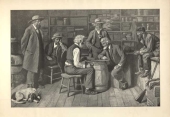The Checker Maven
The World's Most Widely Read Checkers and Draughts Publication
Bob Newell, Editor-in-Chief
Published every Saturday morning in Honolulu, Hawai`i
Noticing missing images? An explanation is here.
Now We Have a Nice Problem
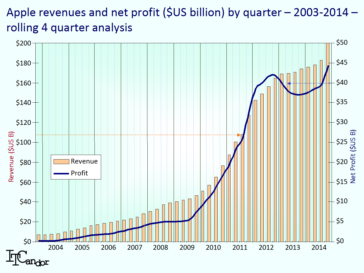
In the chart above, Apple Computer has the "nice problem" of having to figure out what to do with all the money they've made.
"A nice problem to have" is a phrase often heard when someone faces a "dilemma" in which any choice is a good one. Here in Hawai`i, we sometimes have to decide between going to the beach or going to the mall. That's considered a nice problem to have, especially in January.
"A nice problem" in checkers of course means something else, and this week's position, attributed to W. J. Wood, is an example. Mr. Wood himself, after presenting the run-up, stated "Now we have a nice problem." Did he intend a pun or play on words? We rather doubt it.
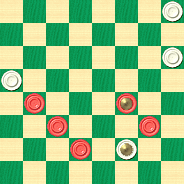
BLACK
Black to Play and win
B:W29,21,20,K6:B16,K14,11,9,7.
We'll warn you that the solution is very long, but it is also very methodical, and you should be able to work out the general direction if not every detail. There is a trap or two along the way, however, so be careful, and when you've given it a nice try, click your mouse nicely on Read More to see the solution and notes.![]()
Fourth of July Celebration

This year our Fourth of July column appears on the day itself, America's birthday. It's a time to reaffirm our patriotism and honor the greatness of America. At The Checker Maven, we're proud American patriots who are profoundly grateful for the opportunities and blessings that come from living in America, and thankful to the men and women who give so much to defend our freedom.

There's nothing like a Fourth of July picnic to celebrate, and there's nothing like a Tom Wiswell problem to make checkers part of the day. Mr. Wiswell was a great American player, problemist, and patriot, one of the "Greatest Generation" who served in our armed forces during the Second World War.
Here's the problem.
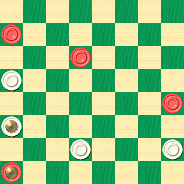
WHITE
White to Play and Win
W:W28,26,K21,13:BK29,20,10,5.
Mr. Wiswell called this one "Strolling Through The Park" because he happened upon some players in the park (presumably Central Park in New York City) and saw the White player miss the win. We wouldn't say that the problem is super-hard, but it does require a good eye and good judgment.
Take a little stroll with this one, then walk your mouse to Read More to see the solution.![]()
Burning the Candle at Both Ends
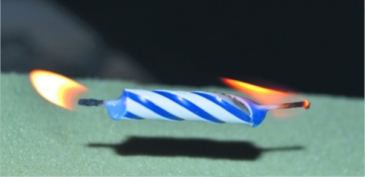
Today's Checker School entry is a fascinating position we call "Burning the Candle at Both Ends," because the terms could just as well have been "White to Play and Draw." To be sure, this isn't in keeping with the traditional meaning of the phrase, but to us it seemed rather apt. See if you agree: First White must find the right move to save the draw. But then Black has the same task and must hew to the correct path. It's a double-ended problem with both ends burning.
BLACK
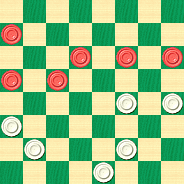
WHITE
White to Play, Black Draws
W:W31,27,25,21,20,19:B14,13,12,11,10,5.
Can you work out both sides of this very interesting endgame? We hope you won't have to burn your own candle at both ends in so doing, and rather than stay up all night, you can always click on Read More to see the solution, a sample game, and detailed notes.![]()
Not So Fast

Last month we brought you "not quite" a speed problem, and this month is no different. We originally were going to publish today's entry as a speedster, but the position requires a little thought, so again we're dispensing with the JavaScript clock and letting you take all the time you need.
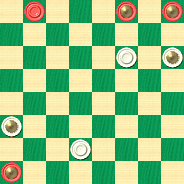
WHITE
White to Play and Win
W:W26,K21,K12,11:BK29,K4,K3,1.
At first glance (aren't those famous last words?) it looks like White has it sewed up, as all three Black kings have no safe moves. That just leaves the single Black man ... oh ... wait ... Black has "the move" and White can't necessarily trap the Black man ... hmmm ... not so simple after all.
The winning technique is well worth knowing, so take your time and see if you can figure it out; then click on Read More to see the solution and notes.![]()
A Textbook Win

"Hitting the books" is something we were admonished to do throughout our academic years, from grade school all the way through graduate school. There was certainly a lot of knowledge in those weighty textbooks, and though acquiring that knowledge wasn't always an enjoyable experience, hitting the books usually paid off.
The same is true with checkers, although we have to admit to enjoying checker study a little more than we enjoyed things like tensor analysis or the works of Kant in the original German. Besides, if we want to be good at checkers, book learning is a necessity, not an option.
Today's study definitely could have come from a checker text.
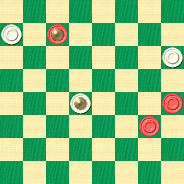
BLACK
Black to Play and Win
B:W28,21,K15:BK27,13,9.
White has just played the losing 19-15. What should White have played? And more importantly, how can Black win? This problem is another example of the beautiful subtlety of checkers.
It's only fair to warn you that it will take Black a little while to win this. But the process is no more than a logical and methodical application of textbook principles.
Write a chapter in your own checker textbook by solving this problem, then click on Read More to see our own annotated solution.![]()
Not Exactly a Speed Problem

Today's problem was sent by regular contributors Lloyd and Josh Gordon of Toronto, Ontario. We were going to feature it as a speed problem, and indeed there are some speed problem aspects here. But the problem goes deeper than the first few moves, as you'll soon see.
So this month, we'll spare you the Javascript clock and let you take as much time as you need. We don't doubt that you'll see the "speed" part pretty quickly. After that, you'll likely need to think it through.
Here's the position.
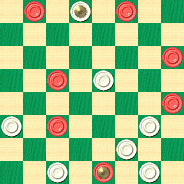
WHITE
White to Play and Win
W:W32,30,27,24,21,15,K2:BK31,22,20,14,12,3,1.
It's an interesting study. Take all the time you need, then click on Read More to see the solution.![]()
The Joker
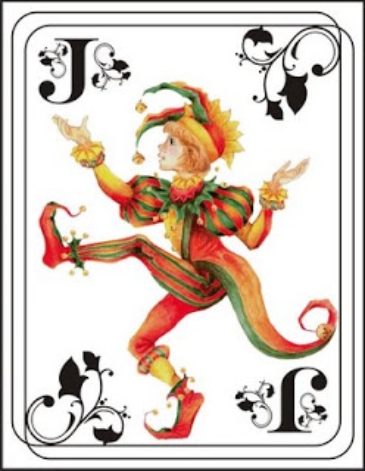
It's been a while since we featured a Chris Nelson problem. Mr. Nelson was a checker analyst and composer who lived in that one-time hotbed of checkers, Brooklyn, New York.
Today's problem gets its name from Tom Wiswell, who says it has fooled many an expert with a "joker" or false solution. Mr. Wiswell continues, "We doubt that you will get it the first time."
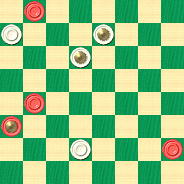
WHITE
White to Play and Win
W:W26,K10,K7,5:B28,K21,17,1.
Don't let the joke be on you. When you think you've got it, check twice and see if you've really solved it. Then click on Read More to see that it really wasn't that hard after all.
Or was it?![]()
The Fastest Speedster Ever

The fastest speedster in the world is supposedly the Hennessey Venom GT, which reached a measured speed of 270.49 miles per hour in 2014, although there's one little hitch. It didn't go into the record books because the run was made in only one direction; apparently, an official record for a production car requires the averaging of two runs in opposite directions. You can buy one of these, by the way, for around a million dollars.
Today we present what is probably the easiest problem we've ever published in the more than ten year history of The Checker Maven. Naturally, we're offering it as a speed problem, and here too there's one little hitch.
We're giving you just three seconds to solve it. But at least it won't cost you anything.
If you're an expert player, you'll get it in a fraction of a second. The rest of us might need a couple of seconds. And even if you don't get it in three seconds, you'll get it before long.
Click on the link below when you're ready, and keep your eyes wide open! Come back and click on Read More to verify your solution.
April Speed Problem (Very easy, three seconds)
![]()
How Bad Can It Get

The famous expression is "The money runs out before the month does." At times, it can get really bad. We've probably all known the feeling.
But can it get even worse? No, we're not trying to drive our Checker Maven readers into depression. There are times, though, when the only thing to do is sit back and have a good laugh.
Here's a checker position in which the idea is to make things as bad as they possibly can get. Not just a little bad, but really bad.
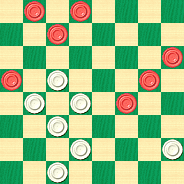
WHITE
White to Play Worst Possible Move
W:W30,28,26,22,18,17,14:B19,16,13,12,6,2,1.
Today's challenge is to pick out the worst possible move on the board. Believe it or not, there's a move here that's so bad ... well, you'll see. (Optimists take note: you can also go ahead and find the best move if you wish.)
Find the worst move and then click on Read More to find out how bad things can be. You're bound to get a laugh, and you're certain to realize that, whatever your own problems may be, they likely have a solution.![]()
The Slowest Speed Problem

We thought for a while before declaring today's offering a "speed problem." It's probably the "slowest" speed problem we've published to date, and the proposed solution time of 45 seconds reflects our view of its difficulty.
Now, some of you will undoubtedly see it right away and solve it in just a few seconds. But we think that for most players, a little thought will be necessary.
Click below to display the problem and start the clock.
March Speed Problem (45 seconds, difficult)
When you're done, come back and click on Read More to check your solution.![]()
The Checker Maven is produced at editorial offices in Honolulu, Hawai`i, as a completely non-commercial public service from which no income is obtained or sought. Original material is Copyright © 2004-2026 Avi Gobbler Publishing. Other material is public domain, AI generated, as attributed, or licensed under CC1, CC2, CC3 or CC4. Information presented on this site is offered as-is, at no cost, and bears no express or implied warranty as to accuracy or usability. You agree that you use such information entirely at your own risk. No liabilities of any kind under any legal theory whatsoever are accepted. The Checker Maven is dedicated to the memory of Mr. Bob Newell, Sr.

